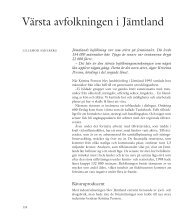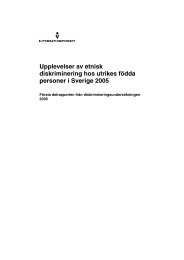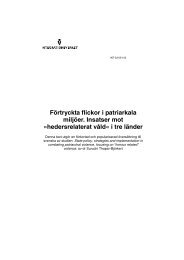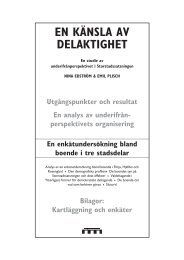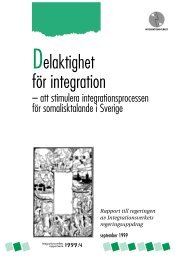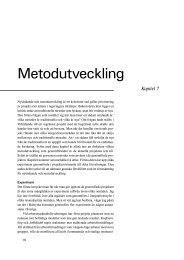- Page 1: Sweden a pocket guide Facts, figure
- Page 4 and 5: Sweden - a pocket guide PRIMARY AUT
- Page 7: Sweden - a pocket guide Contents 7
- Page 10 and 11: 8 Sweden - a pocket guide nity of S
- Page 12 and 13: 10 Sweden - a pocket guide Over the
- Page 14 and 15: 12 Sweden is unevenly populated. Mo
- Page 16 and 17: 14 Sweden - a pocket guide Two-thir
- Page 18 and 19: 16 Sweden - a pocket guide Nearly e
- Page 20 and 21: 18 Sweden - a pocket guide Long ago
- Page 22 and 23: 20 Sweden - a pocket guide Duke Mag
- Page 24 and 25: 22 Sweden - a pocket guide Gustav V
- Page 26 and 27: 24 Sweden - a pocket guide not enou
- Page 28 and 29: 26 Sweden - a pocket guide fees. Fo
- Page 30 and 31: 28 Sweden - a pocket guide GOOD TO
- Page 32 and 33: 30 Sweden - a pocket guide lokal fr
- Page 34 and 35: 32 Sweden - a pocket guide Parliame
- Page 36 and 37: 34 Sweden - a pocket guide Official
- Page 38 and 39: 36 Sweden - a pocket guide local as
- Page 40 and 41: 38 Sweden - a pocket guide and the
- Page 42 and 43: 40 Sweden - a pocket guide nationel
- Page 44 and 45: 42 Sweden - a pocket guide GOOD TO
- Page 46 and 47: 44 Sweden - a pocket guide “Swedi
- Page 50 and 51: 48 Sweden - a pocket guide vårdagj
- Page 52 and 53: 50 Sweden - a pocket guide midsomma
- Page 54 and 55: 52 Sweden - a pocket guide Hundreds
- Page 56 and 57: 54 Sweden - a pocket guide The week
- Page 58 and 59: 56 Sweden - a pocket guide it is tw
- Page 60 and 61: 58 Sweden - a pocket guide Swedish
- Page 62 and 63: 60 Sweden - a pocket guide Not so l
- Page 64 and 65: 62 Sweden - a pocket guide ••
- Page 66 and 67: 64 Sweden - a pocket guide taxa: sc
- Page 68 and 69: 66 Sweden - a pocket guide Fees, av
- Page 70 and 71: 68 Sweden - a pocket guide public t
- Page 72 and 73: 70 Swedish municipalities Southern
- Page 74 and 75: 72 Swedish municipalities Northern
- Page 76 and 77: 74 Swedish municipalities Stockholm
- Page 78 and 79: 76 Sweden - a pocket guide The thre
- Page 80 and 81: 78 Sweden - a pocket guide studieha
- Page 82 and 83: 80 Sweden - a pocket guide tion is
- Page 84 and 85: 82 Sweden - a pocket guide konsumen
- Page 86 and 87: 84 Sweden - a pocket guide against
- Page 88 and 89: 86 Sweden - a pocket guide mit noti
- Page 90 and 91: 88 Sweden - a pocket guide before t
- Page 92 and 93: 90 Sweden - a pocket guide ••
- Page 94 and 95: 92 A job you enjoy. Employers usual
- Page 96 and 97: 94 Sweden - a pocket guide kollekti
- Page 98 and 99:
96 Sweden - a pocket guide In many
- Page 100 and 101:
98 Sweden - a pocket guide The muni
- Page 102 and 103:
100 Sweden - a pocket guide The emp
- Page 104 and 105:
102 Sweden - a pocket guide Insuran
- Page 106 and 107:
104 Sweden - a pocket guide If you
- Page 108 and 109:
106 Sweden - a pocket guide previou
- Page 110 and 111:
108 Sweden - a pocket guide It is o
- Page 112 and 113:
110 Sweden - a pocket guide simply
- Page 114 and 115:
112 Sweden - a pocket guide pay, or
- Page 116 and 117:
114 Sweden - a pocket guide All adu
- Page 118 and 119:
116 Sweden - a pocket guide värnpl
- Page 120 and 121:
118 Sweden - a pocket guide Child a
- Page 122 and 123:
120 Sweden - a pocket guide With th
- Page 124 and 125:
122 Sweden - a pocket guide • Hel
- Page 126 and 127:
124 Sweden - a pocket guide ••
- Page 128 and 129:
126 Sunday breakfast. Weekends are
- Page 130 and 131:
128 Sweden - a pocket guide jämst
- Page 132 and 133:
130 Sweden - a pocket guide and sch
- Page 134 and 135:
132 Sweden - a pocket guide pastors
- Page 136 and 137:
134 Sweden - a pocket guide When a
- Page 138 and 139:
136 Sweden - a pocket guide The cer
- Page 140 and 141:
138 Sweden - a pocket guide buried
- Page 142 and 143:
140 All children are entitled to ca
- Page 144 and 145:
142 Sweden - a pocket guide Respons
- Page 146 and 147:
144 Sweden - a pocket guide Lunch a
- Page 148 and 149:
146 Everyone is entitled to an educ
- Page 150 and 151:
148 Sweden - a pocket guide to thos
- Page 152 and 153:
150 Sweden - a pocket guide The sch
- Page 154 and 155:
152 Sweden - a pocket guide Student
- Page 156 and 157:
154 Sweden - a pocket guide behöri
- Page 158 and 159:
156 Sweden - a pocket guide Upper-s
- Page 160 and 161:
158 Sweden - a pocket guide Komvux
- Page 162 and 163:
160 Sweden - a pocket guide folkrö
- Page 164 and 165:
162 Sweden - a pocket guide Higher
- Page 166 and 167:
164 Sweden - a pocket guide Post-se
- Page 168 and 169:
166 Sweden - a pocket guide GOOD TO
- Page 170 and 171:
168 Sweden - a pocket guide The hom
- Page 172 and 173:
170 Sweden - a pocket guide You pay
- Page 174 and 175:
172 Healthcare is one element of Sw
- Page 176 and 177:
174 Sweden - a pocket guide good id
- Page 178 and 179:
176 Sweden - a pocket guide decline
- Page 180 and 181:
178 Sweden - a pocket guide frikort
- Page 182 and 183:
180 Sweden - a pocket guide Women w
- Page 184 and 185:
182 Sweden - a pocket guide essary
- Page 186 and 187:
184 Sweden - a pocket guide All hos
- Page 188 and 189:
186 Sweden - a pocket guide It may
- Page 190 and 191:
188 Sweden - a pocket guide sexuell
- Page 192 and 193:
190 Sweden - a pocket guide depress
- Page 194 and 195:
192 Sweden - a pocket guide • Che
- Page 196 and 197:
194 Sweden - a pocket guide • Sys
- Page 198 and 199:
196 Freedom of religion guarantees
- Page 200 and 201:
198 Sweden - a pocket guide luthers
- Page 202 and 203:
200 Sweden - a pocket guide Approxi
- Page 204 and 205:
202 Sweden - a pocket guide and Gre
- Page 206 and 207:
204 Sweden - a pocket guide Bahá
- Page 208 and 209:
206 Sweden - a pocket guide Rights
- Page 210 and 211:
208 Sweden - a pocket guide gripa,
- Page 212 and 213:
210 Sweden - a pocket guide kronofo
- Page 214 and 215:
212 Sweden - a pocket guide may lod
- Page 216 and 217:
214 Sweden - a pocket guide that sh
- Page 218 and 219:
216 Sweden - a pocket guide eration
- Page 220 and 221:
218 Sweden - a pocket guide registr
- Page 222 and 223:
220 Sweden - a pocket guide letter,
- Page 224 and 225:
222 Sweden - a pocket guide A munic
- Page 226 and 227:
224 Sweden - a pocket guide borrow
- Page 228 and 229:
226 Sweden - a pocket guide There a
- Page 230 and 231:
228 Sweden - a pocket guide directo
- Page 232 and 233:
230 Sweden - a pocket guide ciation
- Page 234 and 235:
232 Sweden - a pocket guide Every t
- Page 236 and 237:
234 Sweden - a pocket guide intervj
- Page 238 and 239:
236 Sweden - a pocket guide The cit
- Page 240 and 241:
238 Sweden - a pocket guide Natural
- Page 242 and 243:
240 Sweden - a pocket guide ••
- Page 244 and 245:
242 Sweden - a pocket guide ••
- Page 246 and 247:
244 Sweden - a pocket guide • The
- Page 248 and 249:
246 Sweden - a pocket guide Religio
- Page 250 and 251:
248 Sweden - a pocket guide Nationa
- Page 252 and 253:
250 Sweden - a pocket guide Iranska
- Page 254 and 255:
252 Sweden - a pocket guide Syrians
- Page 256 and 257:
254 Index A- C A abortion, abort 18
- Page 258 and 259:
256 Index F-L functional disabiliti
- Page 260 and 261:
258 Index O-R official non-payment
- Page 262 and 263:
260 Index T-Y T tax authority skatt



